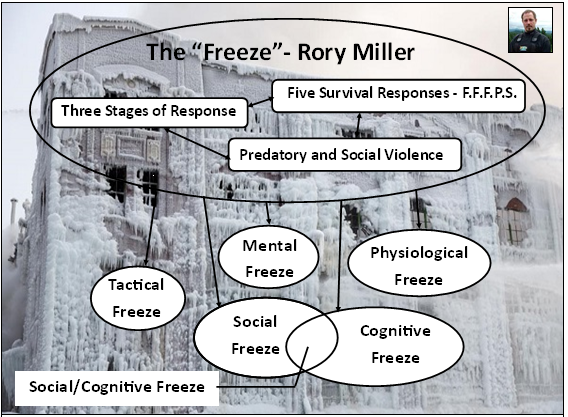
Three Concepts of the Freeze

Three concepts first:
- The three stages of a fight;
- Fight-Flight-Freeze-Posture-Submit (FFFPS);
- and predatory versus social violence.
(1) Three Stages: Being on the receiving end of an unexpected attack you will go through three stages.
- The OC stage. This is where you get hit. If you have trained by operant conditioning (OC) a response to a sudden attack, you may be okay.
- Then you freeze. Almost everyone freezes, even experienced fighters. Some break out of it fast. Some don’t and it tends to end very badly.
- The fight. If you made it through the other two, most of what you have trained will now start to work.
(2) FFFPS Classic Behavioral Biology lists three survival responses to extreme stress, the ‘three Fs’ Fight, Flight and Freeze. Dave Grossman (1) lists four: Fight, Flight, Posture and Submit. All five of the listed responses are hard-wired reactions to an immediate serious threat (note- a living threat. The responses to major disasters are quite different, more limited and predictable see “The Unthinkable” by Amanda Ripley). All are important to this discussion. Fight-Fight-Freeze-Posture-Submit.
The first two are self-explanatory. Freezing will be the subject of this entire paper. Posturing and submitting need some exploration. First we have to distinguish between FFFPS as hard-wired responses and as strategies. These responses have evolved and are hard-wired because they work. Things that work can be used as strategies. In the hard-wired version of these responses Posturing and Submitting will only be used within the species. Submitting to a lion gets you eaten. However, both can make conscious strategies- looking large and being loud will tend to scare off predators; I can’t count the number of times I have befriended a ‘dangerous’ dog by showing puppy/playful body language. However, I cannot think of a single case when either of these strategies happened involuntarily cross species, only as a conscious decision.
So, three hard-wired strategies for predator assaults and another two for social danger.
(3) Predatory vs. Social Violence.
Predatory and Social Violence
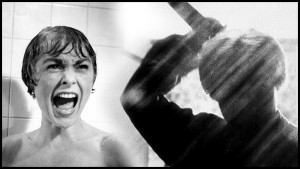
Predatory and Social Violence. For our purpose, violence breaks down two ways: social and predatory. A lot can be said here. The bottom line, in social violence who the victim is is important to the threat, in predatory violence it is not. Social violence- fighting for territory, for ideas, for status- the threat fights against someone he acknowledges as a person. Most people ‘dehumanize’ the enemy with epithets, jokes and insults. A predator does not have to dehumanize because he never really saw the victim as a person anyway, only as a resource.
This breakdown is critical for freezing because some of your brain is wired for surviving a predator attack (FFF) and some for avoiding social violence (PS). Animals have different attack/fighting strategies for intra and interspecies violence. Dogs do not fight other dogs the way that they pack and run a deer to exhaustion. Do not attack each other the way that they kill elk. Elk go antler-to-antler with other elk, but use mostly hooves against wolves. A human, however can choose as a strategy tom use the Monkey dance fighting of establishing social dominance or the predator/hunting behavior of stalking or ambush or sniping or… When and if you are attacked, accurately telling whether the threat is in a social violence or predatory violence mindset is critical. Lastly, most of what people train for and have experience in are very specific levels of social violence. The appropriate skills for those experiences are not good survival choices at other levels of social violence or in predatory assault.
What is freezing? It is not moving under stress. Sometimes it is a choice and a good tactical decision and sometimes it is a very bad decision (sometimes conscious, sometimes not) or involuntary.
One of the factors that complicates this further is time perception under stress. I have a report at home from a cell entry on a barricaded armed threat. From the time the door was opened until I shot I remember about 3 seconds of stuff. The team leader remembers about a minute of stuff, including a conversation that never happened. The rest of the stack wrote it as almost instantaneous.
The team leader was more adrenalized than I was. He perceived a very quick event to take a lot of time and his brain nicely made some stuff up to fill in the details. I was pretty adrenalized, but I was in the zone. Did it take three seconds? It would take me three seconds right now to do what I did there- scan, aim, reject target, acquire another target, aim, fire, rack a round, step out of the way- but in the zone? The rest of the team was probably right. It was pretty quick.
The point is that some of the people who see themselves in slow motion or even frozen, were in fact moving; or were only frozen for a fraction of a second that they remember as a very long time. Personal reports of events, particularly freezes, are very unreliable for establishing facts.
Tactical Freezes

First, let’s dispense with the Tactical Freezes. I’m not too concerned about them because they are choices.
Sometimes, it is a very good idea not to move. Predators key on motion. Not moving allows them to move on to something else. This is the basis of the hardwired freeze response. When you decide to do this, hoping not to be noticed, it is a tactical freeze. It is also a good decision when you are making matters worse. As an old friend used to say, “When a wise man figures out he’s in a hole, he stops digging.” In a social violence situation a tactical freeze may allow the threat to cool down. It is not a good strategy after damage starts. It is also not something that works if you continue to antagonize or challenge with your body language.
There is often (always, actually, but the victim sometimes is not a part of it) a lead-up to an episode of social violence before the three stages mentioned above. The lead-up is where this tactic applies.
The third possible purpose of a tactical freeze is information gathering. If your intuition tingles it may be a good time to stop, look, listen, and smell. And evaluate and plan.
As said, not too concerned about these as freezes, though people do get stuck there.
Video Links:
Physiological Freezes

Second, physiological freezes. I think I can identify two distinct kinds. When the body switches from its normal metabolic state to an adrenalized state, there’s a little tremor as described by Marc in “The Professional’s Guide to Ending Violence Quickly”. It is literally a new mind and body and there is a slight freeze while you switch gears. We’ll do an engines and brakes analogy later, so this stays in theme. The engine is not powering the wheels between gears. Some people switch gears faster than others.
The second is when the danger is so overwhelming, or appears to be, that it triggers the hard-wired freeze response- “I couldn’t move.” Sometimes with the loss of bladder control and everything else. This is the deer in the headlights or the baby bird so terrified it sits in your hands in a near coma. There are a lot of levels of this.
Side note- being frozen can be triggered by fear, but it doesn’t usually feel that unpleasant- kind of warm and floaty with a sound in your ears like the ocean. People who have been so terrified they couldn’t move have described this state and decided that they weren’t really afraid so they weren’t really frozen. It just seemed like a good idea at the time not to move.
Video Links:
Mental/Non-Cognitive Freezes
Mental/Non-Cognitive: A lot of the freezes are mental, which doesn’t mean that they are all cognitive.
Lonnie Athens posits that one of the reasons that change is hard is that no matter how screwed up your life, how horribly you are being victimized or how clear it is that death is inevitable on your current path- you are alive. Your subconscious mind, especially if it has seen a lot of death, is very well aware that your big plan to change your life is only that, a plan. Subconsciously, it knows that planning is a game, this is real and it will try to stick to what works. He called it working from the blueprint. Any time that you attempt to deal with a dangerous situation from a training perspective for the first time, you will get this freeze. If your OC response was good, you may have bought the time to get over it, but now you have to deal with the fact that your hindbrain was indulging the child by letting you take all those martial arts classes and doesn’t believe any of it. You will have to consciously force yourself to act. IME on the second successful action the hindbrain will relent and you can act.
A related phenomenon is behavioral looping, doing the same thing over and over again when it is clear that it is not working. Sometimes, tragically, when it is very clear to an objective outsider that the action will certainly lead to death (Kyle Dinkheller). The mechanism is the same- death may be in the air, but the hindbrain only knows that what you are doing has not gotten you killed and any change might.
Switching maps is the slight hesitation freeze it takes to adjust to a change in situation. When you think you know what you are dealing with e.g. handcuffing a resistive but not dangerous drunk and it suddenly becomes apparent that you were wrong (a knife appears in your stomach) it takes a small amount of time to switch modes. Changing gears again.
Video Links:
Pure Cognitive Freezes
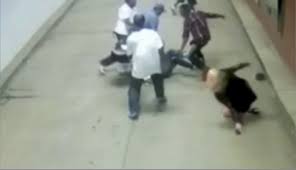
Pure Cognitive Freezes are the thought process errors that can make you freeze.
If too much information is coming in, like a flurry of blows, you can be caught in the OO bounce (From Col. John Boyd’s OODA loop) getting new Observations before you have Oriented to the ones you already have prevents you from ever Deciding or Acting. There are two training strategies for this. Both require using the fact of the OO bounce as a stimulus in an OC stimulus response pair. When you perceive an information overload you either shut down the source of the information or remove yourself from the source of the information.
Because the OO bounce prevents cognitive reasoning, this response must be trained by OC. The nature of OC prohibits two responses to the same stimulus, so you can only train to one of these strategies.
Novelty- if you can’t figure out what is happening, you can’t formulate a response to it. As with any of the cognitive freezes, don’t think of this as purely a logic problem. It happens in a cascade of chemical fear. The phenomenon of “My life passed before my eyes” has been theorized as an attempt to scan memory for something that relates to the situation you are in. Two examples of this from my own experience: Face contact, especially open handed, among adults is a very strong taboo in our culture. When it happens it is a sign of great dominance or great intimacy. Criminals use this, sometimes opening an attack with a ‘bitch slap’ that reliably makes people freeze and fall into a submissive mindset. For most people, the last time they have been slapped was as a child being punished. The mind falls back to that mindset.
The second example- there is rarely a physiological reason to collapse when shot, barring brainstem or spine compromise, but I have seen officers in training, not actually injured at all, collapse and play dead when shot. After all, the only time they have been ‘shot’ before was playing cops-n-robbers as kids and if you don’t die, you’re a cheater. Are the officers who choose to ‘die’ in training the same officers who collapse and bleed out from non-lethal wounds in real life?
Novelty can cross over the line into cognitive dissonance.
If your expectations of a fight do not match what you see, your brain is almost compelled to sort it out and come to an understanding. If the fight you are in doesn’t look, feel or sound like the fight you have trained for, you will freeze. This, IMO, is compounded in martial artists who are very certain that their training has prepared them for reality.
The next two are very closely related. One of the Tactical Freezes is for the purpose of intelligence gathering. This is only appropriate before damage happens. Once boots are flying or weapons are out you need to be doing something. One of the most common reported freezes is the victim trying to figure out ‘why’. Trying to understand is something you can do later, when you are safe. In the moment of assault moving, not understanding, is required.
Very similar is the desire to come up with a plan before acting. Each second spent planning is a second of damage. Damage decreases your ability to execute plans. You can easily die, doing nothing, while groping for the perfect plan.
Video Links:
Social/Cognitive Freeze
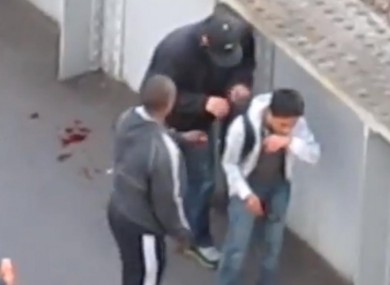
The next types are the Social/Cognitive freezes. These are basically what happens when you attempt to apply your internalized set of civilized rules to an uncivilized situation.
Lack of confidence falls under this heading. If the person believes, on any level, that his training is flawed or unrealistic, that will compound with the hindbrain’s reluctance to work off the blueprint. This is not always a bad freeze- bad training can make situations worse. The cure is almost as bad. It is far easier to instill confidence than competence.
A friend in Montreal, Mauricio Machuca distinguishes between capability and capacity. Damaging another human being is a skill and almost anyone can develop the capability in a short time. Many, however, do not have the capacity to injure another human being. Some internal value or belief- that violence is always wrong or that gouging an eye is unacceptably ‘icky’ will prevent them from acting. In a training environment it is almost impossible to tell if a capacity has actually changed. It is more likely that the person has only convinced themselves that training is just a game and it’s okay to pretend to eye gouge. If so, the freeze is still there, waiting to be triggered.
I sometimes use the analogy of ‘slipping the leash’. Some people either do not have the capacity or it takes extraordinary provocation. Capacity can change under certain provocations. I’ve done it and I’ve heard of many other instructors who motivated a woman in a self-defense class who was not effectively defending herself by telling her that the bad guy was coming after her children.
The person’s identity itself, through the mechanism of denial, can also prevent him or her from acting. Whether it is, “I’m not the sort of person this happens to, this isn’t happening,” or the equally devastating, “I know what I should do, but I’m not the kind of person who would.” The identity, the perception the victim has, prevents action. Even, sometimes at the cost of life.
Ambivalence is a situation that Freud would love. It is the word for when what you want and what is expected of you or what you believe yourself to be come into direct conflict. Mark uses an analogy and an example for this. The analogy is engine and brakes. You really want to clobber your brother in law but you don’t want to listen to your sister bring it up for the next ten years. Less flippant, this is what happens when an officer involved in a deadly force situation starts thinking about lawsuits and the internal affairs process during a life-or-death encounter.
Marc also mentioned alphas pushing betas until the beta fights and that the resultant injury could weaken the alpha to the point that his status was in jeopardy. The resulting equation, fear of injury versus desire to maintain dominance over the beta, would tend to freeze the alpha. I disagree - in a healthy society the alpha doesn’t maintain his position through physical domination. I think the glitch/hesitation equation will come from the fact that going physical with an underling at all shows that the alpha is insecure in his position. Provoking the conflict would compound that. The alpha, in that example, has a lot to lose not from the physical injuries making him vulnerable but from his own actions eroding his reputation (2).
As people grow up in society, they learn a variety of skills to deal with conflict. But that is conflict between civilized people, low-level social violence. When faced with a true predator, someone who does not care about society’s rules or who the victim is, it is an entirely different world. I call this the ‘looking glass effect’. The rules- the social rules; how your brain and body work; what you have been taught about how to handle other people; or what people value no longer apply.
Suddenly finding yourself in an alien culture where you don’t know the rules and your life is at stake creates a pretty deep panic reaction. All of the physiological reasons can combine with information gathering and denial to make you a gibbering wreck.
Video Links:
Pure Social Freeze

Lastly, the Pure Social freeze. In essence, some people are trained to freeze. It probably started as or was intended to be submission, but the programming has gone far deeper. This trained helplessness is a survival strategy for long-term abuse where the abuser chooses to see any sign of independence or spirit as an affront to his social status. I have seen the effects of this training, but there are people far more qualified to write about the process and implications than I am. The similarities between some of the abuse stories and what the victims became have eerie parallels in Elie Wiesel's Night.
Video Links:
Three Stages of Response

Three Stages: Being on the receiving end of an unexpected attack you will go through three stages.
- The OC stage. This is where you get hit. If you have trained by operant conditioning (OC) a response to a sudden attack, you may be okay.
- Then you freeze. Almost everyone freezes, even experienced fighters. Some break out of it fast. Some don’t and it tends to end very badly.
- The fight. If you made it through the other two, most of what you have trained will now start to work.
Five Survival Responses - F.F.F.P.S.
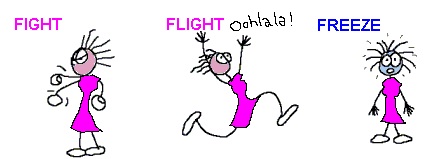
FFFPS Classic Behavioral Biology lists three survival responses to extreme stress, the ‘three Fs’ Fight, Flight and Freeze.
Dave Grossman (1) lists four: Fight, Flight, Posture and Submit. All five of the listed responses are hard-wired reactions to an immediate serious threat (note- a living threat. The responses to major disasters are quite different, more limited and predictable see “The Unthinkable” by Amanda Ripley). All are important to this discussion. Fight-Fight-Freeze-Posture-Submit.
The first two are self-explanatory. Freezing will be the subject of this entire paper. Posturing and submitting need some exploration.
First we have to distinguish between FFFPS as hard-wired responses and as strategies. These responses have evolved and are hard-wired because they work. Things that work can be used as strategies. In the hard-wired version of these responses Posturing and Submitting will only be used within the species. Submitting to a lion gets you eaten. However, both can make conscious strategies- looking large and being loud will tend to scare off predators; I can’t count the number of times I have befriended a ‘dangerous’ dog by showing puppy/playful body language. However, I cannot think of a single case when either of these strategies happened involuntarily cross species, only as a conscious decision.
So, three hard-wired strategies for predator assaults and another two for social danger.
Rory Miller

“Force is a form of communication. It is the most emphatic possible way of saying “no”. For years my job was to say no, sometimes very emphatically, to violent people. I have been a Corrections Officer, a Sergeant, a Tactical Team member and a Tactical Team Leader; I have taught corrections and enforcement personnel skills from first aid to physical defense to crisis communication and mental health. I’ve done this from my west coast home to Baghdad. So far, my life has been a blast. I’m a bit scarred up, but generally happy.”